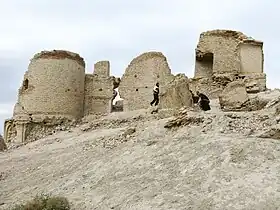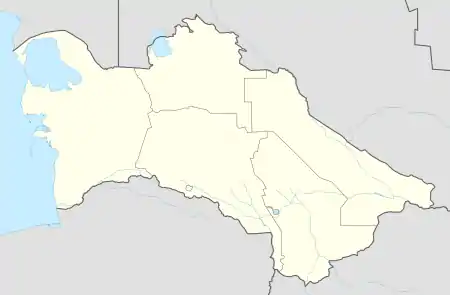Anau
Änew | |
|---|---|
 Ruins of Seýit Jemaladdin Mosque near Anau | |
 Anau Location in Turkmenistan | |
| Coordinates: 37°53′N 58°32′E / 37.883°N 58.533°E | |
| Country | |
| Province | Ahal Province |
| District | Ak bugdaý District |
| Population (1989 census)[1] | |
| • Total | 30,000 |

Anau (Turkmen: Änew) is a city in Turkmenistan. Until 20 December 2022 it was the capital of Ahal Province.[2] It is situated 8 km southeast of Ashgabat, to which it is connected via the M37 highway.
Etymology
The name Anau derives from Turkic Ana ev (Mother's Home), meaning "Mother's Home".
Overview
The city built a new stadium in 2003 and the National White Wheat Museum in 2005 to house artifacts recovered from the area.[3]
City status in the etrap was assigned on February 3, 2008.[4]
The city was designated "Cultural Capital of the Turkic World" for 2024 at the 39th session of the Permanent Council of Ministers of Culture of TURKSOY.[5][6]
Archaeology

The Chalcolithic Anau culture dates to 4500 BC, following the Neolithic Jeitun culture in the cultural sequence of southern Turkmenistan.[7]
Anau was excavated by a joint Turkmen-U.S. archaeological expedition in the 1990s and 2000s.[7] Anau was a stopping point along the ancient Silk Road. Fine painted pottery is found here.
Transportation
The city is connected to Ashgabat and Mary by M37 highway.
The largest nearby airport is Ashgabat International Airport, which offers domestic and international flights.
References
- ↑ Population census 2017 Archived 2012-01-18 at the Wayback Machine, Demoscope Weekly, No. 359-360, 1–18 January 2009 (search for Туркменская ССР) (in Russian)
- ↑ "Постановление Меджлиса Милли Генгеша Туркменистана об отнесении к категории города нового современного административного центра Ахалского велаята и присвоении ему наименования" (in Russian). Электронная газета «Золотой век». 21 December 2022.
- ↑ Picture of Museum, at the site where the earliest settlement was located - pinterest.com
- ↑
- ↑ "Änew şäheri – türki dünýäsiniň medeni paýtagty boldy". TÜRKMENISTAN WE DÜNÝÄ HABARLARY (in Turkmen). 2022-11-05. Retrieved 2022-12-18.
- ↑ Nyýazmämedow, Çerkez (26 December 2022). "Новый облик древнего города" (in Russian). Нейтральный туркменистан. Archived from the original on 27 December 2022. Retrieved 27 December 2022.
- 1 2 Kurbanov, Aydogdy (2018-09-14). "A brief history of archaeological research in Turkmenistan from the beginning of the 20th century until the present". ArchéOrient-Le Blog (in French). Archived from the original on 2020-07-26. Retrieved 2020-05-23.
External links
- ANAW (Anau) iranicaonline.org